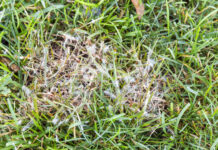
Research to support lawn care experts was presented during the first in-person Turfgrass Field Day hosted by the University of Arkansas System Division of Agriculture. Held at the Milo J. Shult Agricultural Research and Extension Center, it was the first in-person field day event in four years and attracted approximately 175 attendees.
Welcoming the Field Day participants, Deacue Fields, vice president of agriculture for the University of Arkansas System, said turfgrass experts must be able to interact with customers and have the technical knowledge to “do what’s right for the environment.”
Arkansas Agricultural Experiment Station Director Jean-François Meullenet noted that Mike Richardson, professor of turfgrass science for the Division of Agriculture, has built the turfgrass program up over the past 25 years and, with two new faculty members, has “the strongest team we’ve ever had.” The new faculty members are Hannah Wright-Smith, assistant professor of turfgrass weed science, and Wendell Hutchens, assistant professor of turfgrass science and pathology.
“We look forward to having a great impact on your industry over the years,” Meullenet told the field day participants.

Dollar Spot Update
Researchers are testing herbicides to control unwanted grasses and fungicides to control pathogens that cause diseases like brown patch, yellow spot, and dollar spot. With a large part of the event focused on golf greens, Hutchens commented, “Dollar spot is the most common, widespread problem on putting greens. It’s fairly easy to manage, but it occurs everywhere.”
Dollar spot appears as white or tan spots of dead turf about the size of a silver dollar and is common on putting greens that are mowed below 1/8″. Hutchens has compared many different experimental and market-available fungicides with an untreated control. Results indicate that all the fungicides performed “very well” in this trial, but they worked best when applied on 14-day intervals compared to 21-day intervals, asserted Hutchens.
“For dollar spot, there are a lot of good 21-day products, but I really like the idea of leaning on the side of caution with 14-day intervals,” Hutchens said. “In low disease pressure situations, I trust 21-day intervals, but in high disease pressure situations, 14-day intervals are the way to go.”
Based on his research, Hutchens said he was also in favor of using two active ingredients in fungicide applications to cover a wide variety of diseases and combat resistance, or the ability of a pathogen to withstand the fungicide treatment.
“Focusing on one mode of action, or one group of fungicides, that’s where you start to slowly develop resistance,” Hutchens said. “But a critical approach to reducing resistance is keeping inoculum levels down in such low populations that it’s hard to really build up resistance. That’s why we go with regular intervals.”
Broadleaf Weed Control

For lawn care professionals, Wright-Smith gave a presentation on her research to control difficult broadleaf weeds with two new herbicide active ingredients from Corteva Agriscience — Arylex™, available for commercial turf as GameOn and Relzar. She is also testing Rinskor™. Relzar and Rinskor™ are not yet commercially available. The study aimed to compare herbicides for broadleaf weed control and evaluate how new herbicides performed compared to currently used herbicides. Her report states that multiple applications made four to eight weeks apart are still recommended for complete control of broadleaf weeds in turf.
To learn more about Division of Agriculture research, visit here.
Use of product names does not imply endorsement by the University of Arkansas System Division of Agriculture.
For more articles on turfgrass, see:











![[VIDEO] Dickies®: Discover Workwear That’s Anything But Uniform](https://turfmagazine.com/wp-content/uploads/2023/06/1647663814-4b1a2a7742790a9b1e97a3b963477850192e1d6a9dfba9b07214a77bae25d6e3-d-218x150.jpg)






























![[VIDEO] Dickies®: Discover Workwear That’s Anything But Uniform](https://turfmagazine.com/wp-content/uploads/2023/06/1647663814-4b1a2a7742790a9b1e97a3b963477850192e1d6a9dfba9b07214a77bae25d6e3-d-324x160.jpg)